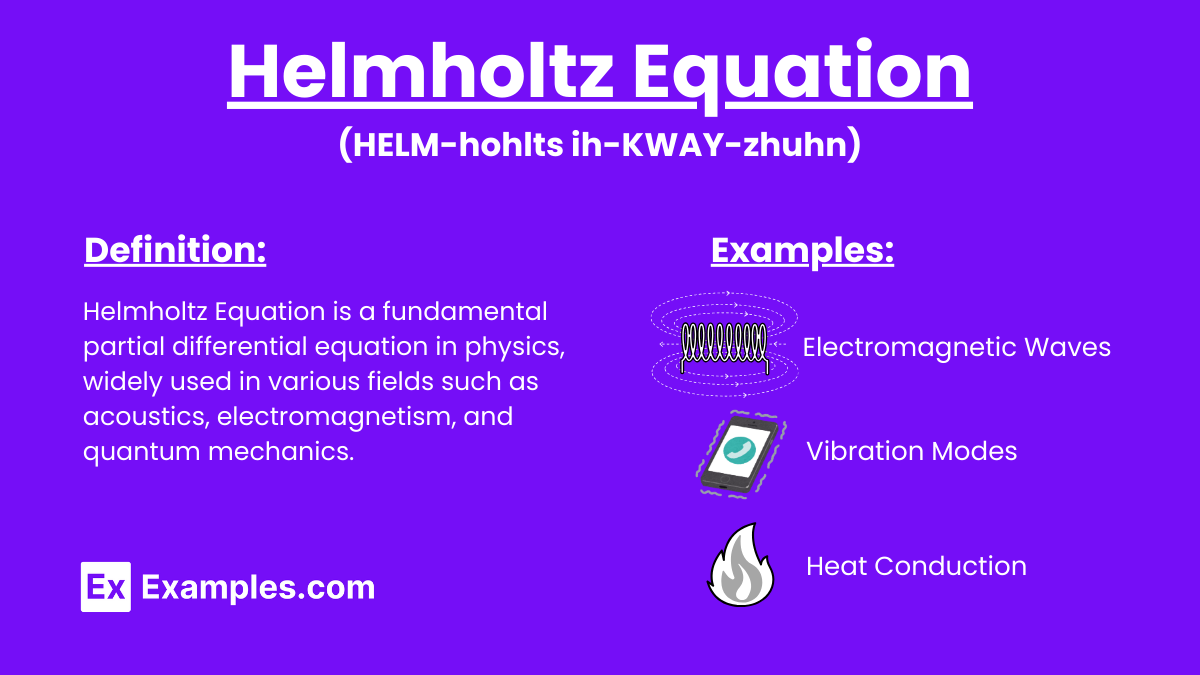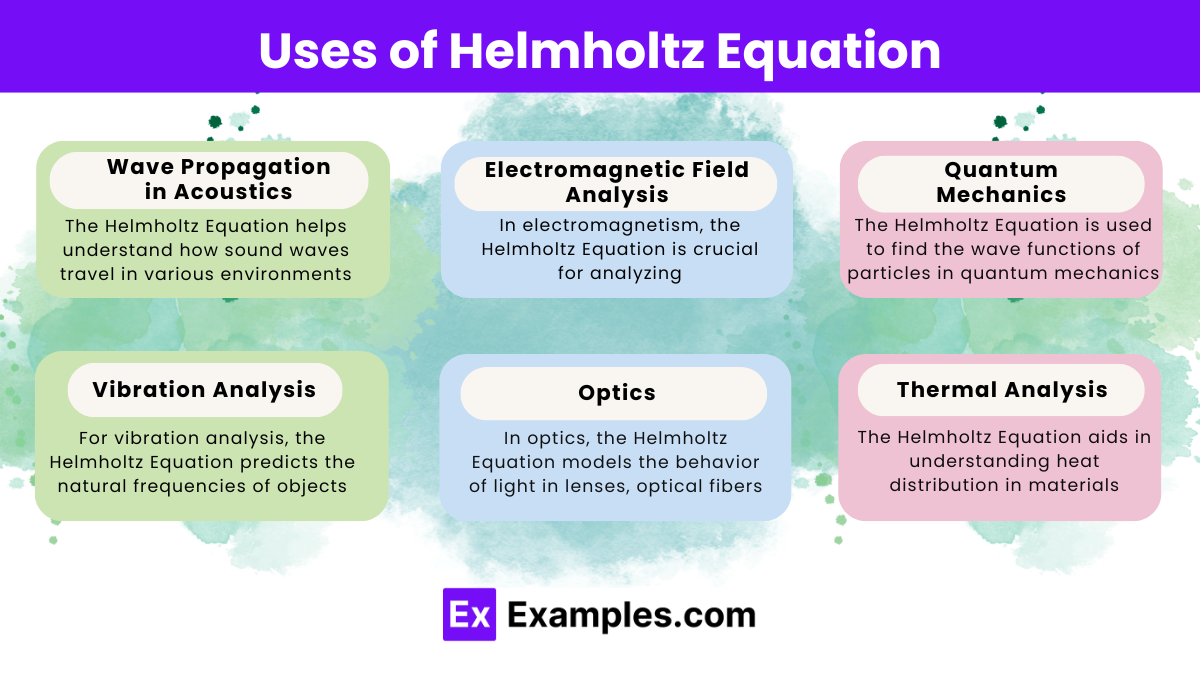What is the general form of the Helmholtz equation in three dimensions?
\( \nabla^2 u + k^2 u = 0 \)
\( \nabla^2 u - k^2 u = 0 \)
\( \nabla^2 u + k u = 0 \)
\( \nabla^2 u - k u = 0 \)


Helmholtz Equation is a fundamental partial differential equation in physics, widely used in various fields such as acoustics, electromagnetism, and quantum mechanics. Named after the German physicist Hermann von Helmholtz, this equation describes how physical fields behave under certain conditions.
Helmholtz’s equation, named after Hermann von Helmholtz, is used in Physics and Mathematics. It is a partial differential equation and its mathematical formula is:
Where,
Helmholtz’s equation finds application in Physics problem-solving concepts like seismology, acoustics, and electromagnetic radiation.
The derivation of the Helmholtz equation is as follows:
(∇²−1/𝑐²∂²/∂𝑡²)𝑢(𝑟,𝑡)=0 (wave equation)
𝑢(𝑟,𝑡)=𝐴(𝑟)𝑇(𝑡) (separation of variables)
∇²𝐴/𝐴=1/𝑐²𝑇𝑑²𝑇/𝑑𝑡² (substitution into the wave equation)
∇²𝐴/𝐴 = −𝑘² and
1𝑐²𝑇𝑑²𝑇𝑑𝑡²=−𝑘² (above two are obtained equations)
∇²𝐴+𝑘²𝐴=(Δ²+𝑘²)𝐴=0 (Helmholtz equation after rearranging)
This was the Helmholtz equation solution.

The German physicist Hermann von Helmholtz formulated the Helmholtz Equation.
The Helmholtz Equation is crucial for modeling and understanding waves, vibrations, and potential fields in various scientific and engineering applications.
It describes how waves travel through different media, providing insights into their behavior and interactions.
It helps model sound wave behavior in various environments, such as rooms, concert halls, and underwater acoustics.
It models the propagation of electromagnetic waves, aiding in the design of antennas, waveguides, and optical fibers.
In steady-state heat conduction, the equation helps model temperature distribution in materials.
An eigenfunction is a solution to the equation that describes a specific mode of vibration or wave propagation.
Solving the equation with specific boundary conditions helps determine the behavior of waves or vibrations in constrained environments.
The wave number k relates to the wavelength and frequency of the wave, defining its spatial variation.
Yes, it models how seismic waves travel through the Earth, aiding in earthquake research and detection.
Text prompt
Add Tone
10 Examples of Public speaking
20 Examples of Gas lighting
What is the general form of the Helmholtz equation in three dimensions?
\( \nabla^2 u + k^2 u = 0 \)
\( \nabla^2 u - k^2 u = 0 \)
\( \nabla^2 u + k u = 0 \)
\( \nabla^2 u - k u = 0 \)
In the Helmholtz equation, what does \( k \) represent?
The Laplacian operator
The wavenumber
The frequency
The amplitude
What is the Helmholtz equation used to describe?
Heat conduction in a medium
The propagation of electromagnetic waves
The diffusion of particles
The flow of fluids
What type of boundary conditions are often used with the Helmholtz equation in problems involving wave propagation?
Neumann boundary conditions
Dirichlet boundary conditions
Periodic boundary conditions
Mixed boundary conditions
For which type of wave phenomena is the Helmholtz equation particularly relevant?
Steady-state thermal conduction
Fluid dynamics
Oscillatory waves
Statistical mechanics
What does the term \( \nabla^2 \) represent in the Helmholtz equation?
The Laplace operator
The gradient operator
The divergence operator
The curl operator
What is the Helmholtz equation's solution method for a problem with spherical symmetry?
Separation of variables
Fourier series
Finite difference method
Method of characteristics
In which coordinate system does the Helmholtz equation become \( \frac{1}{r} \frac{d}{dr} \left(r \frac{du}{dr}\right) + \frac{1}{r^2} \frac{d^2 u}{d\theta^2} + k^2 u = 0 \)?
Cartesian coordinates
Cylindrical coordinates
Spherical coordinates
Polar coordinates
What is the primary difference between the Helmholtz equation and the wave equation?
The Helmholtz equation involves time derivatives, while the wave equation does not.
The Helmholtz equation is time-independent, while the wave equation involves time dependence.
The wave equation involves spatial derivatives, while the Helmholtz equation does not.
The Helmholtz equation is used for diffusion problems, while the wave equation is used for heat conduction.
In the Helmholtz equation \( \nabla^2 u + k^2 u = 0 \), what happens to \( u \) if \( k \) is zero?
\( u \) becomes a constant function
\( u \) becomes a linear function
\( u \) becomes zero everywhere
\( u \) becomes a quadratic function
Before you leave, take our quick quiz to enhance your learning!

